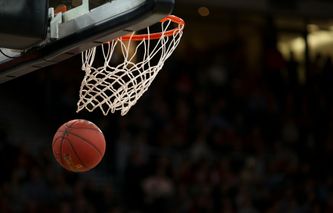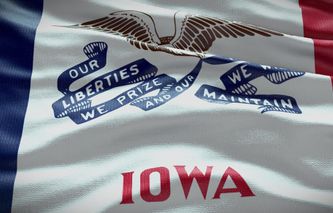 |
|
 Logo 2019-Present |  Alternate Logo 1992-Present |  |
One Citizens Bank Way Philadelphia, PA 19148-5249 | (215) 463-6000 | http://www.phillies.com |
HISTORICAL MOMENTS:
1883 | The Inaugural season does not see much success as the Quakers only won 17 games in a 98 game season, an embarrassing winning percentage of .173, as pitcher John Coleman loses 48 games. |
1884 | The Quakers bring in Harry Wright one of the pioneers in the development of professional baseball to lead the team, but success would not follow in his first season as the Quakers finish in sixth place with a 39-73 record. |
1885 | With a 56-54 record, the Quakers boast their first winning season finishing in third place. |
1886 | The Quakers continue to improve, finishing in fourth place with a solid 71-43 record. |
1887 | With a 75-48 record, the Quakers make their first serious run at the pennant. The Phils would end up falling three and a half games short, losing out to the Detroit Wolverines. |
1888 | The Phillies continue to sit in the middle of the pack posting another winning season at 69-61, but finishing in a distant third place. |
1889 | After four straight winning seasons, the Quakers post a disappointing 63-64 record while finishing in fourth place. |
1890 | The team now known as the Phillies for the home fans in Philadelphia are in the running all year for the pennant fall nine and a half games short while finishing in third place with a solid 78-54 record. |
1891 | The Phillies take a step backward again, finishing in fourth place with a 68-69 record. |
1892 | The Phillies rebound to post an 87-66 record but are no factor in the race for the pennant. |
1893 | In Harry Wright’s final season as Manager the Phillies post another solid 72-57, but once again have nothing to show for it finishing a distant fourth. |
1894 | The Phillies continue to post a winning record at 71-57, but finish way back in fourth place nearly 20 games out. |
1895 | The Phillies are on the fringe of the race for the Championship as they finish in third place within ten games while posting another winning season at 78-53. |
1896 | The lone highlight of a disappointing season comes when Ed Delahanty hits four Home Runs in one game. However, the Phillies would suffer a 62-68 season while finishing in 8th place. |
1897 | The Phillies continue to fall in the standings finishing in 10th place with an awful 55-77 record. |
1898 | After two straight losing season, the Phillies rebound to finish in 6th place with a 78-71 record. |
1899 | The Phillies post their best season to date finishing with an outstanding 94-58 record. However, they would still fall short of 1st place by nine games settling for third. |
1900 | The Phillies start the 20th Century in promising fashion, finishing in third place with a solid 75-63 record. |
1901 | At 83-57, the Phillies finished in second place for the first time since 1887. It would be the high-water mark for the Phils, after many of their star players leave for American League contracts, with most of the player landing deals with newly formed Philadelphia Athletics. |
1902 | With many of their stars leaving to play for the cross-town for the Philadelphia Athletics, the Phillies would plummet to seventh place, finishing 46 games out of first with a record of 56-81. |
1903 | Mired in a miserable 49-86 season tragedy strikes the Phillies when a balcony collapses at Philadelphia Park killing 12, and injuring 232 others. The resulting aftermath would see popular Owner Al Reach and his partner John Rogers sell the team. |
1904 | The Phillies’ struggles continue as they finished in last place while losing 100 games for the first time in franchise history at 52-100. |
1905 | The Phillies rebound nicely off a 100-loss season to finish a respectable fourth place with an 83-69 record. |
1906 | After a solid winning season, the Phillies fall back to earth, finishing in fourth place with a 71-82 record. |
1907 | The Phillies would post a solid 83-64 record under new manager Bill Murray while finishing a distant third in the NL. |
1908 | The Phillies are not a factor in the race for first place, despite posting a solid 83-71 record. |
1909 | After two solid 83-win seasons, the Phillies fall to 5th place with a record of 74-79. |
1910 | Sherry Magee leads the league in batting average, RBI, and runs scored, as the Phillies finished in fourth place with a 78-75 record. |
1911 | The Phillies continue to remain in the middle of the pack, finishing in fourth place again with a record of 79-73. |
1912 | After two straight winning seasons, the Phillies would slip under .500 finishing in 5th place with a record of 73-79. |
1913 | Former New York City police commissioner William Baker becomes the Phillies seventh President in ten years. One of his first moves was to rename Philadelphia Park, Baker Bowl, in his honor. The Phils would put together a solid 88-63 record. |
1914 | The Phillies struggle all season finishing in sixth place with a disappointing record of 74-80. |
1915 | In their 33rd season, the Philadelphia Phillies finally win their first pennant. Leading the way for the Phils is overpowering pitcher Grover Cleveland Alexander who wins 31 games while pitching four 1-hit games. Leading the offense was Gavvy Cravath, who sets a Major League single-season home run record with 24, while leading the league in RBI, and runs scored. Cravath’s record would stand five years before Babe Ruth claimed the record. In the World Series, the Phillies face the Boston Red Sox. In Game 1, Grover Cleveland Alexander outduels Sox ace Ernie Shore 3-1. However, the Red Sox would take a 3-1 series lead after three straight 2-1 victories. In Game 5, the Phillies would take a 4-2 lead top the 8th when Duffy Lewis hit a 2-run homer to knot the score. The Sox would go on to win the game and the series on a Harry Hooper home run in the top of the ninth. |
1916 | The Phillies battle the Brooklyn Dodgers down to the wire for the NL Pennant. The Phils would fall two and a half games short with a 91-62 record. |
1917 | The Phillies finish in second place again with an 87-65 record, as Grover Cleveland Alexander wins 30 games for the third straight season. However, Alexander is dealt to the Chicago Cubs following the season, as club owner William Baker is afraid his star pitcher will not return form World War I. |
1918 | The depleted Phillies fall to sixth place with a 55-68 record, as the Alexander deal backfires, while William Baker continues to sell off more of Phillies stars. |
1919 | The Phillies continue to plummet, finishing in last place with a miserable 47-90 record. |
1920 | Outfielder Cy Williams earns the first of three consecutive NL Home Run Crowns, despite the Phillies landing in the cellar with a 62-91 record. |
1921 | Hitting home runs was easy at Baker Bowl, where the right-field wall stood just 272 feet down the line, as the Phils set a Major League team record with 88 homers. However, the Phillies still finish in last place with a 51-103 record. |
1922 | The Phillies’ struggles continue as they finish with a 57-96 record. However, they would be able to climb out of last place and finish in seventh place. |
1923 | Slugfest was a common occurrence at the Baker Bowl in one game the Phillies lost 26-23 to the Chicago Cubs, setting a single-game combined runs scored record that still stands today. The Phils would go on to finish in last place again, with a 50-104 record. |
1924 | The Phillies continue to be one of the worst teams in baseball as they finish in seventh place with a record of 55-96. |
1925 | The Phillies would show slight improvement despite their 7th straight losing season as they finish in sixth place with a record of 68-85. |
1926 | The Phillies would wind up back in last place while posting another miserable 58-93 record. |
1927 | The Phillies amid another last-place season are forced to play their final 12 home games at the Athletics’ Shibe Park after a section of the grandstand collapses at the Baker Bowl. |
1928 | The Phillies losing ways continue as the club finishes with a woeful 43-109 record, on the way to their sixth Last Place finish in the decade. |
1929 | The Phillies end a miserable decade with another losing record of 58-93 while finishing in fifth place. It was the best record posted by the Phillies in the decade of the ’20s, illustrating how poor the team had played the last ten years. Meanwhile, the cross-town the Athletics would dominate the American League on the way to a World Championship. |
1930 | With five regular players batting well over .300, the Phillies post an incredible .315 team average. Thanks to a pitching staff that had an ERA of 6.71 that gave up a record 1199 runs, the Phillies finished in last place again with a 52-102 record. |
1931 | The Phillies post their 14th straight losing season, finishing in sixth place with a 66-88 record. |
1932 | Chuck Klein wins the NL MVP with a .348 average, 38 home runs, and 137 RBI, as the Phillies finish with a respectable 78-76 record while finishing fourth in the National League. |
1933 | Klein outdoes himself winning the NL Triple Crown. However, the Phils struggle to finish seventh with a 60-92 record. |
1934 | The Phillies’ struggles continue as they finish in seventh place again with a poor record of 56-93. |
1936 | The Phillies fall back down into last place, posting a miserable record of 54-100. |
1937 | The struggles of the Phillies continue as they finish in seventh place with a record of 61-92. It would be the Phillies 19th losing season in 20 years. |
1938 | The Phillies finally move out of the decrepit Baker Bowl. The stadium’s 43-year history was marred by two collapses and was a pitchers nightmare with its short 272-foot fence down the LF line. Now sharing Shibe Park with Athletics, the Phillies continue their losing ways with a 45-105 last-place season. |
1939 | The Phillies finish more than 50 games out of first place while finishing in last place for the second straight season with a record of 45-106. |
1940 | The Phillies’ misery continues, as they finish in last place for the third straight year, finishing 50 games out of first with a record of 50-103. |
1941 | The Phillies losing was continue as the club posts its worst record ever at 43-111, topping 100 losses for the fourth season in a row. |
1942 | The Last Place Phillies lose 109 games extending their embarrassing string of 100-loss seasons to 5 straight. |
1943 | Wearing predominately blue uniforms, the Phillies are dubbed Blue Jays by the Philadelphia Press. The “Blue Jays” end their string of 100-loss seasons by finishing seventh with a 64-90 record. |
1944 | The Blue Jays fall back to last place, posting a 61-92 record as they finish more than 30 games out of first for the 12th straight season. |
1945 | Returning to their red look, and the name Phillies, Philadelphia also see a return of 100-loss seasons, as the Phillies finish in last with a 46-108 record. |
1946 | The Phillies climb out of last place and end a string of 13 seasons of finishing 30 or more games out of first place while finishing in fifth place with a record of 69-85. |
1947 | The Phillies post their 16th straight losing season and 39th in 40 years while finishing in fifth place with a record of 62-92. |
1948 | The Phillies go through three managers as they climb to third place despite posting their 17th straight losing record at 66-88. |
1949 | The Phillies post their first winning season in 17 years while finishing in third place with an 81-73 record. |
1950 | The Whiz Kids were Robin Roberts, Richie Ashburn, and Del Ennis. They were Granny Hamner, Willie Jones, and Curt Simmons. All were products of the Phillies farm system, young, exciting players who, with a handful of key veterans, gave the franchise one of its most beloved teams. The Phillies led the NL most of the way, and with 11 games left to play had a seven-game lead. The team, however, went into a late-season tailspin, losing 8 of 10 games. On the last day of the season, the Phils had a one-game lead. Playing the final game against the Brooklyn Dodgers at Ebbets Field, the Phillies won, 4-1, in 10 innings on Dick Sisler’s dramatic three-run homer. With a 91-63, the Phillies had their second pennant and were on the way to the World Series. However, In the World Series, the Wiz Kids are swept by the New York Yankees. However, the Phillies did not embarrass themselves losing four straight close games, as the Yankees pitchers outdueled the young Phillies by scores of 1-0, 2-1, 2-1, and 5-2. |
1951 | The Phillies are unable to recapture their previous year’s magic fading to 5th place with a 73-81 record. |
1952 | With Robin Roberts putting up an impressive 28-7 record, the Phillies bounce back and finish in fourth place with a solid 87-67 record. |
1953 | The Phillies finished 22 games out of first place despite a respectable 83-71 record. |
1954 | With the Athletics moving to Kansas City, the Phillies have Philadelphia all to themselves as they struggle to finish with a 75-79 record while finishing in 4th place. |
1955 | OF Richie Ashburn wins the first of two batting crowns. However, the Phillies would struggle to finish fourth place with a 77-77 record. |
1956 | The Phillies returned to the struggles that have plagued them for 30 years as they fall to fifth place with a record of 71-83. |
1957 | The Phillies are a non-factor in the pennant race again as they finish 22 games out of first while posting a 77-77 record and placing fifth in the National League. |
1958 | The Phillies return to the cellar with a 69-85 record, despite Richie Ashburn winning his second Batting Crown. |
1959 | The Phillies’ struggles continue as they finish in last place again with a record of 64-90. |
1961 | Gene Mauch’s first full season as Phillies’ manager is marred by a Major League Record 23-game losing streak. The Phillies would finish last place for the fourth year in a row with a 47-107 record. |
1963 | The Phillies continue to improve, finishing in fourth place with a solid 87-75 record, only 12 games behind the Los Angeles Dodgers for the NL Pennant. |
1965 | The Phillies followed up their late-season collapse by finishing in a fifth Place tie with an 85-76 record. |
1967 | The Phillies play mediocre baseball all season on the way to finishing in fifth place with an 82-80 record. |
1969 | During a miserable 63-99 season, the lone bright spot comes when pitchers Jerry Johnson, Woodie Fryman, Larry Jackson, and Rick Wise hurl four consecutive shutouts. |
1971 | A new era dawns in Philadelphia as the Phillies begin to play in Veterans Stadium. The Vet is in line with the trend of the times boring faceless circular cookie cutter multipurpose stadiums being built for both baseball and football. The Phillies would go on to finish in last place with a 67-95 record. |
1973 | In a year in which the entire NL east struggled, the Phillies are the only team that is not a factor in the late-season push for the pennant as they finished in last place with a 71-91 record. |
1975 | With Mike Schmidt and Greg Luzinski becoming a potent force in the middle of the lineup, the Phillies’ improvement continues. The Phillies challenge the Pirates all season for the Division title before falling six and a half games short with an 86-76 record. |
1977 | With Steve Carlton capturing his second Cy Young with 23 wins, and a potent lineup that saw seven players reach double digits in Homers, the Phillies repeat their 101-61 performance to capture their second straight division title. In the NLCS, the Phillies faced the Los Angeles Dodgers. After splitting the first two games in Los Angeles, the Phillies blew a 5-3 lead with two outs in the ninth inning. The Dodgers would win the series in four games with a 4-1 victory in the finale. |
1979 | The Phillies sign future hit king Pete Rose away from the Cincinnati Reds. Despite the addition of Rose, the Phillies struggle all season finishing in fourth place with an 84-78 record. Meanwhile, GM Dallas Green replaces manager Danny Ozark near the end of the season. |
1981 | The Phillies jump out in front again are in first place with a 34-21 record when a strike interrupts the season for 50 days. When baseball returned, it was decided to break the season into two halves meaning the Phillies were already in the playoffs. This was a good thing as the Phillies struggled with a 25-27 record in the second half. However, the regular season saw Mike Schmidt take the home run crown and NL MVP again. Meanwhile, Pete Rose gets his 3,631st career hit breaking Stan Musial’s career NL hit record. After the season, the Phillies faced the 2nd half Champion Montreal Expos in a five-game series that saw Expos end the Phillies hopes for a repeat in five games. |
1983 | With a roster full of older players, the Phillies begin the season dubbed the “Wheeze Kids” by the local press. However, the old guys do alright as Steve Carlton collects his 300th career win and becomes the all-time strikeout king, a position he would only hold temporally, before being passed by Nolan Ryan. However, Carlton was outdone on the pitching staff as John Denny capture the Cy Young with a 19-6 record. The Phillies would reclaim the NL East tike by winning 14 of their last 16 games to finish with a 90-72 record. In the NLCS, the Phillies would face the Los Angeles Dodgers who beat them 11 out of the 12 times they met in the regular season. With Steve Carlton winning twice and timely hitting from NLCS MVP Gary Matthews, the Phillies would stun the Dodgers in 4 games to make a return trip to the Fall Classic. In the World Series, the Phillies would face the Baltimore Orioles, and with the stellar pitching of John Denny captured the opener in Baltimore 2-1. However, the Orioles would win the next four games to take the series four games to one. |
1985 | The lone highlight of a disappointing fifth-place 75-87 season came in June when the Phillies clobbered the Mets 26-7 behind two first-inning home runs by Von Hayes, including a Grand Slam. This marked the first time that a player homered twice in the same inning. |
1987 | Mike Schmidt has another big season smacking 35 HR on the way to breaking the 500-career barrier. Meanwhile, on the mound, Steve Bedrosian saves 40 games on the way to earning the Cy Young. However, the Phillies would struggle to finish fourth with an 80-82 record. |
1988 | The Phillies finished in last place for the first time in 15 years, posting a lousy record of 65-96. |
1989 | Mike Schmidt, sighting sore knees, suddenly retires during Memorial Day Weekend. Schmidt, who ended his career with 548 career home runs more than any other third baseman. As a tribute to Schmidt, fans still vote him to start at 3B in the All-Star Game. The Phillies would go on to finish in last place with a 67-95 record. |
1990 | The Phillies’ struggles continue as they post their fourth straight losing season while finishing in 4th place with a 77-85 record. |
1991 | Manager Nick Leva is fired after just 13 games, as the Phillies again finish belo0w .400 with a 78-84 record. |
1992 | The lone highlight of another last-place season comes when Mick Morandini turns an unassisted triple play in a game against the Pittsburgh Pirates. The Phillies 70-92 record camouflaged a strong finish that saw the Phillies come close to climbing out of the cellar where they stood all season long. |
1993 | Led by a colorful group of hard-charging players headed by Lenny Dykstra, Darren Daulton, and John Kruk, the Phils fielded an exciting team that captured the fancy of fans throughout the country. After a blazing 45-17 start, the Phillies coasted to the Eastern Division title, holding first place all but one day. During the season, the Phils played a memorable doubleheader with the San Diego Padres that because of three rain delays ended at 4:40 a.m. Dykstra led the NL in runs (143) and hits (194), and for the first time, the team drew more than three million fans. The underdog Phillies would face the Atlanta Braves in a pulsating NLCS. After falling behind two games to one, the Phillies came from behind to win the last three games to stun the Braves in six games. Curt Schilling (was named Most Valuable Player in the series, as the Phillies became only the third team to leap from last place to the World Series in one year. After dropping two of the first three games to the Toronto Blue Jays in the World Series, the Phillies looked to tie the series in Game 4. With Milt Thompson belting a three-run triple in the first inning while driving in five runs and Dykstra poling two homers in a four-RBI night, the Phillies took a 14-9 lead after seven innings, were well on the way to even the series. The Phils pen would unravel, and the Phillies would end up losing to the Blue Jays 15-14 in the highest-scoring game in World Series history. The loss put the Phillies down three games to one in the series. However, a stellar pitching performance by Curt Schilling sent the series back to Toronto. The Phillies would overcome a 5-1 defect in Game 6 to take a 6-5 lead, but the Mitch Williams would blow it again, yielding a series-winning three-run HR to Joe Carter in the bottom of the ninth. |
1994 | Ravaged by injuries, the Phillies struggle all season and stand in fourth place with a 54-61 record on August 12th when the season ended prematurely due to a Player’s Strike. |
1995 | The Phillies finish a distant second in the NL East posting a 69-75 record, as baseball struggles to get on its feet following the devastating strike. |
1996 | Veterans Stadium hosts the All-Star Game as the Phillies return to the cellar posting a terrible record of 67-95. |
1997 | 3B Scott Rolen has a spectacular first season earning the Rookie of the Year, while Curt Schilling has an impressive season eclipsing the 300 strikeout mark. However, the individual success does not translate to team success as the Phillies finish in last again with a 68-94 record. |
1998 | Curt Schilling repeats his 300-strikeout performance, as the Phillies continue to struggle, finishing in third place with a 75-87 record. |
1999 | The Phillies post their sixth straight losing season finishing in third place with a record of 77-85. |
2000 | Amid another last-place 65-97 season, the Phillies comply with Curt Schilling’s request and deal him before the trade deadline to the Arizona Diamondbacks for Pitchers Vincente Padilla Omar Daal, and 1B Travis Lee. |
2001 | With new manager Larry Bowa at the helm, the Phillies get off to a fast start and lead the Eastern Division for much of the first half of the season. In the middle of the season, the Phillies’ weak pitching would begin to catch up with them as the Braves zoomed past them. However, the Phillies would stay close to the Braves all season, finishing in second with an 86-76 record. Larry Bowa would go on to claim the manager of the year, as the Phils posted a 21-game improvement over 2000. |
2002 | The Phillies get off to a miserable start as they find themselves nearly 20 games below .500, and in last place early in the season. Along the way, it becomes apparent the Phillies would not be able to re-sign Scott Rolen, who turned down a big-money contract extension in spring trading, as a rift between him and manager Larry Bowa begins to distract the rest of the team. Shortly after the All-Star break, Rolen would be traded to the St. Louis Cardinals. Without Rolen, the Phillies would play better down the stretch climbing out of last place and briefly above .500 before finishing in third place with an 80-81 record. Following the season, the Phillies would use the money they offered Rolen to sign Free Agent slugger Jim Thome. |
2003 | The Phillies entered their final season in Veterans Stadium amidst an air of optimism with their prize free agent Jim Thome. In April, it would be their significant pitching acquisition Kevin Millwood that would steal the show pitching a no-hitter on April 27th against the San Francisco Giants. Millwood would not live up to expectations most of the season, posting a mediocre 14-12 season as the Phillies’ hopes for challenging for the division title faded early. The Phillies would find themselves in the thick of the race for the Wild Card as Jim Thome went on a second-half tear on his way to an NL high 47 homers. Down the stretch, the Phillies bullpen would cost them several key games as closer Jose Mesa, who had a terrible 6.52 ERA, was publicly criticized and benched by Larry Bowa. Needing to win a crucial series against the Florida Marlins in the final week to keep their playoff hopes alive, the Phillies are swept as they lose seven of their last eight games finishing in third place with an 86-76 record. Following the season, the Phillies addressed the weakness in the bullpen by acquiring closer Billy Wagner from the Houston Astros. |
2004 | With the highly anticipated opening of their new stadium on the horizon, the Phillies started the season on the road, where the struggled losing five of six. On April 12th, Phillies fans finally had the state of the art ballpark the dreamed of as Citizen’s Bank Park hosted its first game. However, Phillie fans would go home disappointed as they lost to the Cincinnati Reds 4-1, on the way to a mediocre April and a 10-11 record. In May, the Phillies would play better as they spent much of the month battling for first place. However, the next two months would see the Phillies continue to underachieve as the Atlanta Braves climbed their way to first place after a poor start. The Phillies would continue to struggle in August as their hopes of winning the division faded. Through it all, the growing tension between the players and manager Larry Bowa was cited as one of the reasons the Phillies were not playing up to their potential. In September, the Phillies would put together their finest month with a 19-8 record. However, it was too little too late as they had to settle for second place and an 86-76 record, as Bowa was fired before the final two games of the season. |
2005 | As the season began under new manager Charlie Manuel, the Phillies had an immediate concern as Jim Thome dealt with elbow and back pain that would have him struggling from the start. As Thome struggled, the Phillies struggled with a 15-21 record through 36 games. Eventually, the Phillies decided to put Thome on the Disabled List and called up Rookie Ryan Howard from Scranton/Wilkes-Barre. With Bobby Abreau and Pat Burrell leading the way on offense the Phillies caught fire on Memorial Day Weekend as they ran off a string of 17 wins over their next 20 games to climb out of last place and into a tight NL East battle as all five teams were above or at .500 almost the entire season. Through much of the next two months, the Phillies were in a giant jumble of teams battling for the NL East with the Wild Card as a consolation gift. Despite the continued absence of Thome, who was quickly beginning to resemble Wally Pipp as Ryan Howard began to get hot in the second half smashing 22 homers on his way to become a new fan favorite and winning the NL Rookie of the Year. As September began, the Phillies led the Wild Card race and were only a few games behind the Atlanta Braves for 1st place in the NL East. However, a five-game losing streak, which included a sweep at the hands of the Houston Astros would have the Phillies playing catch up the rest of the year. There were several bright moments in September as the Phillies won five of seven against the Braves to keep the division title hopes alive. However, it would not be enough as the Phillies fell two games short of the Division Title and one game short of the Wild Card with a solid record of 88-74. Following the season, the Phillies would end any debate over who was their 1B as they traded Jim Thome to the Chicago White Sox for CF Aaron Rowand. |
2006 | The Phillies stumbled out of the gate, dropping six of their first seven games as they put themselves in an early hole. After closing April with a 10-14 record, the Phillies turned things around in May as they embarked on a seven-game winning streak igniting a stretch in which they won 12 of 13 games. One of the games a 2-0 rain-shortened win over the Mets made new CF Aaron Rowand an instant fan favorite as he ran down a long fly ball by Xavier Nady with the bases loaded and two outs giving up his body. Rowand would suffer a broken nose and would be forced to go on the DL, but he would only miss two weeks as he became a symbol for the Phillies’ never-quit spirit. Despite the never give up the mentality of the players on the field, the team continues to struggle. When they ended July at 49-55, management looked toward the future trading Bobby Abreau and Corey Liddle to the New York Yankees for prospects, while David Bell was sent to the Milwaukee Brewers. The deals would have killed an ordinary team’s spirit, but instead reenergized the Phillies, as Ryan Howard already on a post-All-Star tear was nearly impossible to get out. At the same time, Chase Utley embarked on a 35-game hitting streak as the Phillies won 15 of 22 to climb back over .500 and into the thick of the Wild Card race. This forced the same front office that was waving the white flag to reverse course and acquire Jamie Moyer, a veteran left-hander from the Seattle Mariners. The Phillies would battle for the Wild Card until the end of the season. The Phillies started the final week of the season, losing two of three games on the road to the Washington Nationals as they fell just three games short of the postseason with a record of 85-77. Despite falling short, Ryan Howard was rewarded for his monster year as he followed up Rookie of the Year with an NL MVP thanks to a franchise-record 58 homers and 149 RBI. Sadly the Phillies would be touched by tragedy following the season as Corey Liddle, who was traded on July 31st, was killed in a plane crash just following the season. |
2007 | At the start of the season SS Jimmy Rollins boastfully declared the Phillies the team to beat in the NL East. When the season began, they were simply the team that got beat as they dropped 10 of their first 13 games. The Phillies would start playing better baseball as April came to a close, but were still below .500 and a distant third Place as June began. A three-game sweep of the New York Mets on the road in early June would foreshadow the Phillies, second-half turnaround, as they entered the All-Star break with a 44-44 record. The Phillies also entered the All-Star Break one loss away from history, as they became the first team to lose 10,000 games in their franchise history on July 15th when they were beaten by the St. Louis Cardinals at home 10-2. As July came to a close, the Phillies began to make their move winning nine games in a ten-game stretch, as Rookie pitchers like Kyle Kendrick called up from AA Reading helped fill the void left by the injuries of Freddy Garcia and Jon Lieber. However, the Phillies have yet to make a serious move on the Eastern Division-leading Mets until the end of August when they swept them four straight at Citizen’s Bank Park to cut the Mets season-long lead to two games. However, a rough start to September had the Phillies falling back again, as they trailed the Mets by seven games with 15 games left in the season. Fortunately, the Phillies had one more series with the Mets left, and one last chance to at least make it a race in the NL East. Like they had twice previously, the Phillies swept the Mets, with Jimmy Rollins, the SS who boastfully declared the Phillies the team to beat getting the big hit on several occasions. The sweep would be the catapult to the most unbelievable two week stretch in Phillies history as they won 12 of their last 15 games, as the Mets performed a collapse not seen since the Phillies in 1964. Every day the Phillies got closer and closer as the Mets tailspin continued. With three games left, the Phillies finally reached first place for the first time, as they clinched the division on the final day of the season with a 6-1 win over the Washington Nationals as the Florida Marlins jumped on the Mets early for an 8-1 win. The Phillies did indeed end up being the team to beat with a record of 89-73. For his efforts in the Phillies’ late-season surge, Jimmy Rollins would be rewarded with the NL MVP award. Rollins was the second straight Phil to take home the hardware, as he became the first player in MLB history to collect 200 hits, 15 triples, 25 home runs, and 25 stolen bases in the same season. In the playoffs, the Phillies faced the Colorado Rockies in the NLDS; the Rockies had an unbelievable comeback of their own winning 13 of their last 14 games, including a tiebreaker against the San Diego Padres to secure the NL Wild Card berth. Despite playing a grueling game against the Padres, the Rockies drew first blood in Game 1 against the Phillies a sold-out Citizen’s Bank Park, scoring three runs in the 2nd inning. The Phils would cut into the lead in the 5th as Aaron Rowand and Pat Burrell hit back-to-back home runs, but that would be as close as the Phillies would get as the Rockies took the opener 4-2. Game 2 would not be any better as the game turned in the fourth Inning when Kaz Matsui hit a grand slam off Kyle Lohse as the Rockies won 10-5. There would be no more miracles for the Phillies, as the Rockies completed the sweep with a 2-1 win in Game 3 at Coors Field. |
2008 | Coming off their startling comeback to win the National League Eastern Division, the Phillies entered the season with a renewed swaggered and exchanged words with several players on the New York Mets in the media. Early on, it was the Phillies who were having the upper hand as they spent much of the first half in the first place, as Chase Utley put up MVP type numbers in the first half with 25 Homers, 69 RBI, and a .291 batting average. However, as interleague play began, the Phillies hit some rough waters, struggling against the American League posting a 4-11 record. They would still go into the All-Star Break in first place with a record of 52-44. The second half would come down to a battle between the Mets and the Phillies, and the Mets after a lousy start passed the Phillies after the All-Star Game, as the two rivals heated things up exchanging the lead several times. Entering September, the Phillies trailed the Mets by one game, as Ryan Howard began to heat up. Howard, who was putting up excellent power numbers all season, had struggled with his batting average and strikeouts most of the season, but come September, he became the most dangerous hitter in the league. Despite the power surge from Howard, the Phillies still slipped three and a half games behind the Mets entering the final 16 games of the season. Almost on cue, the Phillies began to make another surge as the Mets broke down, with Howard’s MVP push beginning in earnest with a four-game pounding of the Milwaukee Brewers that got the Phils back to within one game of the Mets. The Phillies would go south and would continue to heat up, taking five of six from the Atlanta Braves and the Florida Marlins on the road, as they regained their first-place perch. The Phillies would not slip again as they closed the season by winning 13 of their final 16 games. Winning their second straight division title with a record of 92-70, as Ryan Howard finished the season leading the majors with 48 HR and 148 RBI, with a league-high 12 homers and 33 RBI coming in the Phillies division-winning September run. The key for the Phillies division title was the bullpen, as the Mets pen struggled all season. At the same time, Brad Lidge, acquired in the off-season from the Houston Astros, was perfect, saving all 41 save opportunities he had. In the NLDS, the Phillies faced the Milwaukee Brewers and continued to stay red hot, as Cole Hamels dominated, allowing just two hits over eight innings while striking out nine as the Phillies took the opener 3-1. In Game 2, facing the dominant CC Sabathia, the Phillies continued to have all the answers as Brett Myers worked out a walk after fouling off several pitches to fluster the Brewers ace. After Myers got on, Jimmy Rollins followed up with a walk of his own to load the bases, which set the stage for Shane Victorino to deliver the big blow with a Grand Slam that gave the Phillies a solid 5-2 victory. As the series shifted to Milwaukee, the Phillies suffered a setback in Game 3, losing 4-1. However, led by two home runs from Pat Burrell, the Phillies advanced to the NLCS with a 6-2 victory. Facing the Los Angeles Dodgers, the Phillies again got the jump in the NLCS, as Chase Utley and Pat Burrell homered in the sixth inning to lead the Phillies to a 3-2 victory, behind Cole Hamels, who fought through early struggles to get the win. In Game 2, it was the Phillies bats that won the day, a Brett Myers went 3-for-f with three RBI while getting the win, as the Phillies took a 2-0 series lead with an 8-5 win. After Jamie Moyer struggled in a Game 3 loss in Los Angeles, the Phillies rallied to take a 3-1 lead two-run homers from Shane Victorino and Matt Stairs in the eighth inning that gave the Phillies 7-5 win. Brad Lidge continued to his regular-season dominance in the playoffs, with his fifth save. In Game 5, it came down to Cole Hamels, who slammed the door shut, allowing one run on five hits over seven innings while striking out five, as the Phillies advanced to the World Series for the first time in 15 years with a 5-1 win, with Hamels earning the NLCS MVP. |
2008 World Series | In the World Series, the Phillies found themselves playing the Tampa Bay Rays, as Chase Utley delivered the first shot, smacking a two-run home run in the first inning. Carlos Ruiz would add an RBI double in the fourth inning, as Cole Hamels dominated again, earning the win with a solid seven-inning effort as the Phillies took the opener 3-2. After dropping Game 2, the series shifted to Philadelphia, where a sold-out crowd braved a cold October rain, and a long delay to watch the Phillies take control of the series. Carlos Ruiz infield single with the bases loaded in the ninth inning knocked home Eric Bruntlett to give the Phillies a dramatic 5-4 win at 1:47 a.m. The Phillies would show up wide awake the next game, as the Phillies bats exploded with a 10-2 victory that gave them a commanding 3-1 series lead, as Ryan Howard homer twice, with Jayson Werth and pitcher Joe Blanton who got the win each delivering blasts of their own. With Cole Hamels on the mound, there was an air of anticipation over Philadelphia in Game 5, as Cole Hamels took the mound. The Phillies took an early 2-0 lead, but the Rays battled back as the rains began to fall tying the game in the sixth inning with the chilly rain creating puddles everywhere. Had this been a regular-season game, the game may have been stopped, and the Phillies gave a 2-1 rain-shortened five-inning win. In the playoffs, nobody wanted to see the World Series decided on a rain-shortened game. The game would be suspended tied 2-2 in the middle of the sixth inning. Two days later, the game resumed, with the Phillies quickly retaking the lead on an RBI single by Jayson Werth. The Rays would respond with a run of their own on a home run by Rocco Baldelli in the seventh inning. The Phillies continued to have all the answers with Pedro Feliz delivering home Eric Bruntlett with an RBI single in the bottom seventh inning. From there it was up to the Phillies bullpen, where Brad Lidge continued to be perfect striking out Eric Hinske to earn the save as the Phillies won their second World Championship in five games with a 4-3 win in Game 5, that took three days to complete, but erased years of frustration in Philly, while Cole Hamels was named World Series MVP. |
2009 | After their second World Series Championship, the Phillies began to get the respect they have been seeking for years, as they were viewed by many to be the team to beat in the National League again. However, early in the season, they suffered a significant loss off the field, as longtime announcer Harry Kalas died before an April 13th game against the Washington Nationals. He suffered a heart attack while preparing to call that game from Washington. Early on in the season, the Phillies had bullpen troubles, as Brad Lidge, who was light out in 2008, was lit up time and time again in 2009. As the Phillies were making their run for the title, Lidge was perfect out of the bullpen in 2008, saving 41 games without giving up a lead, while posting a 1.95 ERA. In 2009 he would blow 11 saves while posting an awful 0-8 record with a terrible 7.21 ERA, as he fought off injuries. Despite the struggles of Lidge, the Phillies did not miss a beat as they grabbed first place in the National League in May and never relinquished the top spot for the remainder of the season. Pacing the Phillies, drive for a third straight division championship was a powerful line up that had four players hit more than 30 home runs, six players score more than 90 runs, and five players knock in more than 75 RBI. One of the players to be on all three lists was RF Jayson Werth, who had a breakout season with 36 homers, 99 runs scored, and 98 RBI. Meanwhile, it was Ryan Howard who once again led them all with 45 homers and 141 RBI. Even while they were in first place at the trade deadline, the Phillies felt they needed some pitching help as they acquired Cliff Lee along with Ben Francisco from the Cleveland Indians for Carlos Carrasco, Jason Donald, Lou Marson, and Jason Knapp. The Phillies also signed Pedro Martinez to strengthen their rotation. Lee would post a 7-4 record, while Pedro was 5-1 as the Phillies won the East with a record of 93-69. One big highlight of the season came on August 23rd when utility man Eric Bruntlett turned in the play of the year against the New York Mets by ending the game with an unassisted triple play. |
2009 Postseason | In the NLDS against the Colorado Rockies, the Phillies got off to a fast start as they won the opener 5-1, behind the pitching of Cliff Lee, who retired 16 straight batters to get the win. After suffering a 5-4 loss in Game 2, the Phillies went to Colorado and won 6-5 in Game 3 in a thrilling, back-and-forth game that saw Ryan Howard drive in the winning run with a sac fly in the ninth inning. Trailing 4-2 in the ninth inning of Game 4, the Phillies showed their ability to rally as Ryan Howard doubled home Shane Victorino and Chase Utley to tie the game. Howard would come into score on Jayson Werth’s single as they won the game 5-4 to set up an NLCS rematch with the Los Angeles Dodgers. After splitting the first two games in Los Angeles, the Phillies bats exploded in Game 3, as they jumped out to an early 6-0 lead and went on to seize control of the series with an 11-0 win as Ryan Howard and Shane Victorino each drove in three runs. At the same time, Cliff Lee allowed just three hits while striking out ten over eight innings pitched. In Game 4, it appeared as if the Dodgers would answer back as they held a 4-3 in the 9th inning. However, Jimmy Rollins delivered a dramatic two-out double to score Eric Bruntlett and Carlos Ruiz with the tying and winning runs to give the Phillies a 5-4 win and a commanding 3-1 series lead. With Jayson Werth hitting two home runs, the Phillies would close out the Dodgers with a 10-4 win in Game 5 to reach the World Series for the second straight season, as Ryan Howard was named NLCS MVP. In the World Series against the New York Yankees, the Phillies would draw first blood, winning Game 1 behind Cliff Lee 6-1, who pitched a complete game allowing just one run on six hits, while striking out ten. Chase Utley provided the offense with two home runs. After the Yankees bounced back with a 3-1 win in Game 2, the series shifted to Philadelphia, where the Phillies got off to a fast start in Game 3, scoring three runs in the second inning. Phillies pitching was unable to slow down the Yankees bats as they lost 8-5 to give the Bronx Bombers control. In Game 4, the Phillies would rally from a 4-2 deficit to tie the game on homers by Chase Utley and Pedro Feliz. However, Brad Lidge, who pitched well through most of the postseason, faltered in the ninth inning, allowing three runs after retiring the first two Yankee hitters, as the Yankees took a 3-1 series lead with a 7-4 win. The Phillies would not go down without a fight at Citizens Bank Park as they used the same formula in Game 1 with Cliff Lee getting the win, as Chase Utley hit two home runs, to tie a Fall Classic record with five long balls as the Phillies won 8-6 to send the series back up the New Jersey Turnpike to New York City. In Game 6, the Phillies would have no answers for Hideki Matsui, who had six RBI to pace the Yankees to a 7-3 win to claim the World Championship. |
2010 | Despite the performance of Cliff Lee down the stretch and in the postseason, the Phillies felt they would be unable to re-sign him and sent him to the Seattle Mariners for prospects, at the same time the Phillies were working on a deal with the Toronto Blue Jays to land Roy Halladay. The trade for Halladay included a 3-year, $60 million contract extension. Coming off two straight trips to the World Series, the Phillies would enter the season as the clear favorites again. The acquisition of Halladay would pay off right away as he stepped in and became the best pitcher in the National League, not only winning games but eating innings. On May 29th, he would make history as he tossed a perfect game against the Florida Marlins, in a 1-0 win in Miami. Despite Halladay’s pitching, the Phillies would struggle in June, losing their grip on first place, which they held through much of April and May as they posted a mediocre 13-13 record. The average play would continue in July, as they fell seven games behind the Atlanta Braves in the National League East. However, as the month came to an end, the Phillies began to find their game-winning eight in a row. On July 29th, the Phillies improved their pitching staff; by picking up Roy Oswalt from the Houston Astros for Oswalt was s for J. A. Happ and two minor league players. The deal for Oswalt would make the Phillies nearly unbeatable down the stretch as they posted an 18-10 record in August, that would only be outdone by a 21-6 mark in September, as they erased the Braves lead, and went on to win their fourth straight division title with a record of 97-65. Roy Halladay, who finished the season with a 21-10 record and an ERA of 2.44, would win the Cy Young Award. |
2010 Postseason | In the playoffs, Roy Halladay would be on the mound as the Phillies faced the Cincinnati Reds in the NLDS. Halladay who never pitched in the postseason before had a playoff debut for the ages, allowing just one walk, while striking out eight, as he became only the second pitcher in baseball history to toss a No-Hitter in the playoffs beating the Reds 4-0 in Game 1 at Citizen’s Bank Park. In Game 2, the Phillies trailed early 4-0 but took advantage of shoddy fielding to win the game 7-4. The Phillies would complete the sweep with a 2-0 win in Cincinnati for Game 3, as Cole Hammels pitched a complete game, allowing just five hits while striking out nine Reds. In the NLCS, the Phillies would face the San Francisco Giants, as Roy Halladay faced Tim Lincecum in a battle of Cy Young winners. Halladay would be unable to match his performance in the NLDS, as he allowed two Home Runs to Cody Ross, as the Giants won the opener in Philadelphia 4-3. The Phillies would bounce back in Game 2, as Roy Oswalt allowed just one run on three hits while striking out nine as Jimmy Rollins knocked in four runs to lead the way a 6-1 win. As the series shifted to San Francisco, the Phillies bats fell silent in Game 3, losing 3-0 as Matt Cain allowed just two hits over seven innings. Game 4 would go back and forth as the Giants jumped out to a 2-0 lead before the Phillies took the lead with a four-run fifth. The Giants would re-take the lead in the sixth inning, as Jayson Werth tied the game 5-5 with an eighth-inning double. In the ninth inning, Charlie Manuel would roll the dice and bring in Roy Oswalt to pitch. The move would not work, as Juan Uribe knocked home the winning run with a sacrifice fly to give the Giants a commanding 3-1 series lead. In a rematch of Lincecum and Halladay in Game 5, the Phillies would win 4-2 to send the series back to Philadelphia. Hoping to force a seventh, the Phillies jumped out to a 2-0 lead early. However, the Giants bullpen would shut them down the rest of the way as the Giants would win the game 3-2 on Juan Uribe’s eighth-inning homer. The Giants would win the first World Series from 1954 when they played in New York. Following the season, the Phillies would lose Jayson Werth to Free Agency when he signed with the Washington Nationals. The Phillies’ already strong rotation would get even better as they picked up Cliff Lee. Lee, a free agent who was pursued by the New York Yankees, chose to return to the Phillies, by signing a 5-year, $120 million contract, with a club option for a 6th year that would make the contract worth $135 million. |
2011 | With the re-acquisition of Cliff Lee, the excitement level for the Phillies was off the charts as they entered the season the overwhelming favorites to win the World Series. It was as if the Phillies were dealt the winning hand with Cliff Lee, Roy Halladay, Roy Oswalt, and Cole Hamels completing a staff called four aces. The Phillies would get off to a fast start, sweeping the Houston Astros to begin the season at home. The Phillies would hold or share first place all but one day in April as they posted a record of 18-8. On May 1st, during a 2-1 loss to the New York Mets in 14 innings, the Sunday Night crowd began chanting U-S-A as word around Citizen’s Bank Ballpark spread that Navy Seals had killed Osama Bin Laden. The Phillies would continue to cruise in May, as they ended the month with a 34-21 record. Three of the four aces were pitching as well as expected, but a back injury to Roy Oswalt had him on the disabled list most of the summer. However, Vance Worley had a breakout season and pitched like an ace posting a record of 11-3. The Phillies also spent most of the season without Brad Lidge in the bullpen. In his place, the Phillies had Ryan Madson fill in nicely with 32 saves, as Antonio Bastardo emerged as the ideal setup man. The story of June was the pitching of Cliff Lee, who went 5-0 with a microscopic ERA of 0.21. Lee had more RBI three than earned runs allowed two. The Phillies were as dominant as the experts predicted, as they sent five players Roy Halladay, Cliff Lee, Cole Hamels, Placido Polanco, and Shane Victorino to the All-Star Gamer in Phoenix. Despite continuing their dominance over the National League East, the Phillies felt they needed to add some offense at the trade deadline, so they picked up Hunter Pence in a trade with Astros for four prospects. The Phillies would finish the season with a record of 102-60, winning their fifth straight division title, as they sent a franchise attendance record with 3,680,718 fans attending games at Citizen’s Bank Ballpark. |
2011 NLDS | Despite an eight-game losing streak after clinching the NL East, the Phillies finished the season strong winning their last four games, including a sweep of the Atlanta Braves that knocked their division rivals out of the Wild Card spot. With the Braves knocked out, the Phillies would face the St. Louis Cardinals in the NLDS. Unlike 2010, Roy Halladay would not pitch a No-Hitter in the opener, as the Cards jumped out to a 3-0 lead on a first-inning home run by Lance Berkman. The Phillies would comeback as Halladay did not allow another run in eight innings pitched, winning 11-6 as Ryan Howard had four RBI and Raul Ibanez had three to lead the way in a late-game Phillies onslaught. In Game 2, the Phillies would jump out to an early 4-0 lead, only to have the Cardinals claw their way back to a 5-4 win. As the series shifted to St. Louis, the Phillies got a big blast from Ben Francisco, who hit a three-run home run in the seventh to break open a scoreless pitchers duel between Cole Hamels and Jaime Garcia. However, again the Red Birds battled back winning 5-3 in Game 4 to set up a showdown between Chris Carpenter and Roy Halladay with the series on the line in Philadelphia. Like they did in Game 1, the Cardinals got to Halladay early, scoring a run on Skip Schumaker’s first-inning double. Once again, that was all Halladay would allow, but that was enough as the Phillies managed just three hits against Carpenter, who went the distance as the Cardinals won the game and the series 1-0. Add injury to insult on the last at-bat of the season Ryan Howard again made the last out this time he would rupture his Achilles tendon in the process. |
2012 | The Phillies began the season with several critical injuries as Chase Utley had injuries to both knees. Ryan Howard was still recovering from tearing his Achilles Heel, making the final out in the NLDS in 2011. Looking to fill the gaps, the Phillies signed Jim Thome and acquired Ty Wiggington in the off-season. The Phillies also signed closer Jonathan Papelbon to strengthen their bullpen. Opening Day would be a preview of the Phillies season as they beat the Pittsburgh Pirates 1-0, with Roy Halladay and Papelbon combining for a shutout. The Phillies injury-depleted lineup would be the story early in the season, as they struggled through April, posting a record of 11-12. Among the frustrated Phillies was Cliff Lee, who did not win a game until July 4th. Still, it was not due to poor performance as his run support was hard to find, in one April no decision Lee pitched ten shutout innings, but the Phillies lost to the San Francisco Giants in 11 innings 1-0. Lee would finish the season at 6-9, with an ERA of 3.16. The lack of offense and the Phillies were struggling just to win games in the first half as Chase Utley did not make his season debut until June 28th, while Ryan Howard was out of the lineup until July 6th. The injury bug spread to the rotation as Roy Halladay went on the DL in May with a shoulder strain. When Halladay returned, his velocity was down, as he struggled through the second half, posting an 11-8 record with a hefty ERA of 4.49. However, both got off to slow starts, as the Phillies playoff hopes were all but buried by the All-Star break as they held a record of 37-50. Utley would end the season with 11 home runs and 45 RBI in 83 games, while Howard had 14 homers and 56 RBI, with a disappointing .219 average in 71 games. After the All-Star Break, the Phillies appeared to be turning the corner, as they won 8-of-11 games, but with them sitting 13 games out of Wild Card position, the team decided to start re-tooling for the future. One big part of their plans was securing a contract extension for Cole Hamels, who was the Phillies’ most consistent pitcher during the season, posting a record of 17-6, with an ERA of 3.05 and 216 strikeouts. Hamels’ extension was worth $144 million over six years. At the same time, the Phillies traded away players who did not fit in their plans for the future as Hunter Pence, who was their best hitter in the first half with 17 home runs and 59 RBI before the trade was sent to the San Francisco Giants Nate Schierholtz, Tommy Joseph, and Seth Rosin. In contrast, Shane Victorino and Joe Blanton were traded to the Los Angeles Dodgers. The Phillies would spend the entire second half trying to get back to .500, which they finally did in September as they posted 81-81 and finished in third place. |
2013 | After a disappointing season, the Phillies looked to rebound and reclaim the National League East, as they looked to add some offense in the off-season by picking up Michael Young and Delmon Young. However, early on, it was the Phillies pitching that was a concern as they lost five of their first seven games. One pitcher who struggled early was Roy Halladay, who had a poor Spring Training and was hit hard in his first two starts. Halladay would get wins in his next two starts, but again got hammered in his last start in April as the Phillies ended the month with a 14-2 loss to the Cleveland Indians and went into April with a record of 12-15. Roy Halladay would continue to get hit hard in May, as the Phillies lost to the Miami Marlins 14-2 on May 5th. After the game, Halladay went on the disabled list and had surgery on his shoulder, missing the next three months. While Halladay was out, the Phillies barely trod water and began slipping out of the playoff chase with an eight-game losing streak after entering the All-Star Break at .500 (48-48). The Phillies continued to struggle in August, as Manager Charlie Manuel was fired on August 16th, with the team sitting in fourth place with a record of 53-67. The dismissal came just days after Manuel won his 1,000th game as a manager of the Phillies, ending one of the most successful tenures in franchise history. Ryne Sandberg would manage the Phillies the remainder of the season, and the team responded to the managerial change, by winning seven of nine as Roy Halladay returned. Halladay would finish the season with a record of 4-5 and an ERA of 6.82 and retire following the season. The Phillies meanwhile would finish the season with a lackluster record of 73-89. Among the only bright spots was the breakout season of Left Fielder Dominic Brown, who led the team with 27 home runs and 81 RBI, while Cliff Lee was the most reliable pitcher posting a record of 14-8 with an ERA of 14-8. |
2014 | Coming off a disappointing season, there was an air of frustration for the Philadelphia Phillies. Just a few years earlier, the Phillies had the best pitching staff in baseball and won 100 games, and it all crumbled quickly. Fans’ anger was primarily directed at General Manager Ruben Amaro Jr., who was even having trouble making deals with the Phillies draft picks. The Phillies start the season with an interleague series against the Texas Rangers, winning the opener 14-10. The Phillies would have an up and down, April posting a record of 13-13, a record some called “pleasantly mediocre.” Troubles would begin to deepen in May, as the Phillies lineup slumped all month with a .230 average that ranked worst in the National League, the Phillies would post a record of 11-16 during May. June would be more of the same, as the Phillies lineup continued to scuffle as the team posted a record of 12-17. Despite having several players on the trading block, the Phillies were inactive at the trade deadline, bring further criticism directed towards GM Ruben Amaro Jr. The Phillies would make a few waiver deals in August, sending Roberto Hernandez to the Los Angeles Dodgers and John Mayberry Jr. to the Toronto Blue Jays. The Phillies season continued to plod along as they languished in last place. September would begin with a 7-0 win over the Atlanta Braves, with Cole Hammels, Jake Diekman, Ken Giles, and Jonathan Papelbon combining to pitch a No-Hitter. However, that was about the only highlight in the season’s final month as players feuded with Manager Ryne Sandberg, including Jimmy Rollins, who remained unhappy in Philadelphia. Papelbon also had his troubles with Sandberg and was booed off the mound after blowing the lead in a September 14th game at the Miami Marlins at Citizens Bank Park. The Phillies closer shoved umpire Joe West and gave a vulgar gesture directed toward the fans. Jonathan Papelbon would be suspended for seven games for his actions. The Phillies would go on to finish in last place with a record of 73-89. |
2015 | After a last-place finish, expectations were as low as they could be as the Philadelphia Phillies were rebuilding for the future. The Phillies’ main goal was to trade off their aging stars and begin making way for younger players, though the farm system lacked quality talent. During the off-season, the Phillies traded away Jimmy Rollins, receiving minor leaguers Tom Windle and Zach Eflin from the Los Angeles Dodgers in return. At the same time, Kyle Kendrick signed a free-agent deal with the Colorado Rockies. As the season began, the Phillies were looking to deal more players like Chase Utley, Ryan Howard, Jonathan Papelbon, and Cole Hamels were all on the bloc. Through the first three months, the Phillies were by far the worst team in baseball as Ryne Sandberg was fired on June 25th, with the Phillies languishing with a record of 26-48. Pete Mackanin would manage the team for the rest of the season. After hitting the All-Star Break with an atrocious record of 29-62, the Phillies played their best baseball of the season, winning 11 of 13 games over the final two weeks of July. On July 25th, Cole Hamels made history tossing a No-Hitter against the Chicago Cubs in a 5-0 win at Wrigley Field, striking out 13 in the process, while issuing just two walks. It would be the final appearance for Hamels in a Phillies uniform. He was traded six days later to the Texas Rangers with Jake Diekman in exchange for Matt Harrison, Nick Williams, Jorge Alfaro, Jake Thompson, Alec Asher, and Jerad Eickhoff. The Phillies also shipped Jonathan Papelbon, who earlier became the franchise leader with 113 saves in May to the Washington Nationals for Nick Pivetta. In August, the Phillies would deal Chase Utley to the Dodgers in receiving Darnell Sweeney and John Richy in return. The Phillies would spend nearly the entire season in last place as they narrowly avoided 100 losses with a record of 63-99. |
2016 | After a 99-loss season, the Philadelphia Phillies had nowhere to go but up, in Pete Mackanin’s first full season as manager. With improved starting pitching and relief, the Phillies played better at the start of the season the Phillies showed they were going to be a more competitive team as they posted a record of 14-10 in April. Earning the closer job was Jeanmar Gomez, who recorded eight saves, while Vince Velasquez started 5-1. The Phillies continued to play well until the middle of May, as they sat with a record of 24-17 a half-game out of first on the 17th. However, they closed May by losing 9-of-11 and dropped to .500 and never again poked above it. June would see the downward spiral continue, as the Phillies went 9-19. The Phillies would finish the season with a record of 71-91, finishing fourth in the National League East. Still, there were some positives Odubel Herrera was an All-Star for the first time, batting .286 with 87 runs scored while hitting 15 home runs with 49 RBI. Maikel Franco would lead the team with 25 homers and 88 RBI, as Ryan Howard spending most of the season on the bench finished out his Phillies career with 25 homers and 59 RBI. Jeanmar Gomez finished the season with 37 saves, while Vince Velasquez finished 8-6 with an ERA of 4.12. |
2017 | After four straight losing seasons, the Philadelphia Phillies hoped to take a step forward in 2017. Cesar Hernandez began the year with a bang, leading off on opening day as the Phillies beat the Cincinnati Reds 4-3 to open the season. After splitting their first six games on the road, the Phillies stumbled coming, home suffering a three-game sweep at the hands of the New York Mets. The Phillies had some positives in April, winning six straight to sit at 11-9 through their first 20 games. A three-game losing streak on the road against the Los Angeles Dodgers to end April singled troubled times ahead. Wins would be scarce over the next two months as the Phillies found themselves with the worst record in baseball after a combined record of 15-40 in May and June. After entering the All-Star Break at 29-58, the Phillies began to show signs of improvement, as they ended July on a five-game winning streak. August would be another rough month for the Phillies, as suffered losing streaks of five games and six. Despite the struggles, there were things for Phillies fans to look forward to as they began calling up some of their top prospects. Rhys Hoskins Making his debut on August 10th, Hoskins set Philadelphia on fire hitting 11 home runs in his first 18 games, with 25 RBI as he earned Rookie of the Month honors in the National League. Rhys Hoskins continued to put up big power numbers in September as he finished fourth in Rookie of the Year voting while playing in just 50 games as he finished the year with 18 home runs and 48 RBI with an average of .259. The Phillies would finish the season strong, and avoided 100 losses, by posting a record of 66-96. It was not enough to save manager Pete Mackanin’s job as he was fired at the end of the season. |
2018 | The Philadelphia Phillies entered the season with moderate expectations, as the team was expected to take a step forward. The biggest story was the hiring of new skipper Gabe Kapler, whose credo centered around sabermetrics and analytics, a concept which angers old-timers who feel that it has no place in the game. Along with the addition of Kapler, the Phillies focused on improving their roster by bolstering the bullpen with veterans Tommy Hunter and Pat Neshek. The Phillies traded away shortstop Freddy Galvis intending to showcase top prospect J.P Crawford and made a somewhat questionable signing by giving starter Jake Arrieta a three-year $60 million contract. An even more questionable signing of 1B Carlos Santana with the same contract of three years $60 million. The season would not start great for Kapler, as he made a very controversial move during the season opener by pulling Aaron Nola after 5.1 innings. However, Nola had only given up three hits over 68 pitches. The Phillies went on to blow 5-0 lead against the Atlanta Braves after Nola was pulled, and the media called for Kapler’s head. Despite the hiccup, the Phils got off to a strong start, compiling records of 30-21 over the first two months. Fans were starting to see something special with Nola and Arrieta at the top of the rotation. Not everything was great, as Carlos Santana was hitting below the Mendoza line until the end of May. The Santana signing had forced Rhys Hoskins to remain in the outfield, and the young slugger was quickly turning into one of the worst defensive outfielders in the game. The Phillies overall had become one of the worst defensive teams in the league. J.P Crawford was looking even worse than Santana at the plate and was placed on the DL by the beginning of May with a strained forearm, only to come back in June for a few games before he was hit by a pitch and broke his hand, leading to the end of his tenure with the Fightin’ Phils, as he would only have a few more at-bats at the end of the season, still struggling badly. The Phillies would go on to a 15-13 June and winning five straight games in July going into the All-Star break. The subpar June showed a glaring weakness in the pitching staff for the Phils, as Arrietta was dropping off badly, and young starters Nick Pivetta and Vince Velasquez struggling all season. In the second half, the only reliable pitcher was Nola, who had become a certified ace, with his first All-Star selection. Zach Eflin was also appearing to have his breakout season carrying a 3.15 ERA into the break. The bullpen was a mess a Pat Neshek, and Tommy Hunter were constantly coming on and off the DL. The bats were performing around the league average. Hoskins did not look like the same player that was called up last August. Scott Kingery was a big disappointment after signing a six-year extension in the offseason. Nonetheless, the Phils were tied with the Braves atop the NL East at the break. The Phillies began to slowly decline after the All-Star Game, ending July losing four of the last five games. In August, playoff chatter, and all the team had to do was play a little above .500 for the rest of the season to be in the hunt for a Wild Card berth, as the Braves began to run away with the division. A 13-14 August would set the Phillies back. They would need to have a strong September to get into the Wild Card. During September, the Phillies went into a tailspin, finishing 80-82. Abysmal pitching and subpar hitting ended the Phillies playoff hopes. The only player who finished strong was Aaron Nola, who had made his way into the Cy Young conversation with a 17-6 record and a 2.37 ERA. The season ended more question marks than it began with. Hoskins led the team with 34 home runs and 96 RBI. Carlos Santana was a disappointment and traded back to the Cleveland Indians at the end of the season. Jake Arrieta had a pedestrian record of 10-11 with a 3.96 ERA. Written by Chuck Safarowic |
2019 | With a drought lasting seven years, the Philadelphia Phillies were hoping to return to the postseason for the first time since 2011. After a late-season collapse, the Phillies looked to bolster their offense. The first moves came in December when the Phillies acquired Jean Segura, Juan Nicasio, and James Pazos in a trade with the Seattle Mariners. They also signed former MVP Andrew McCutchen. In January, the Phillies inked veteran late-inning reliever David Robertson to a two-year contract. They swung a trade with the Miami Marlins for J.T. Realmuto, giving up top prospect Sixto Sanchez, along with Jorge Alfaro and Will Stewart. The Phillies capped off their busy offseason with the largest free-agent contract of all time, 13 years, and $330 million for Bryce Harper. After spending a whopping $477 million in new money and becoming the first team to add three position players in one offseason who were All-Stars the previous season, the front office was looking for tangible progress under second-year manager Gabe Kapler. The Phillies started the season on a high note, sweeping Atlanta and winning seven of their first nine games. Through the first two months of the season, attendance rose nearly 12,000 a game compared to the year prior, with the Bryce Harper effect in full tilt. The Phillies held a share of first place as late as June 11th, with a record of 38-29. It would be their final day in first place as they never were able to play consistent winning baseball. Injuries played a significant role in the outcome of the Phillies. Andrew McCutchen was lost to a season-ending knee injury in June, while the bullpen was ravaged all season, as no team had more relievers on the Injured List than Philadelphia. In terms of overall injuries, the Phillies were second only to the New York Yankees. As the season wore on, the Phillies quickly faded. Once again, they played terrible baseball in September, going 13-16 to finish in fourth place with a disappointing record of 81-81, leading to the dismissal of manager Gabe Kapler. Despite the mediocre finish, there was a tangible improvement with the offense. The Phillies scored nearly 100 more runs, approximately 30 more home runs, and slugged .427 compared to .393. Harper led the way with 35 home runs and 115 RBI while on the mound, Aaron Nola led with a 12-7 record and a 3.97 ERA.Written by Nick Matlack |
CHAMPIONSHIP TEAMS
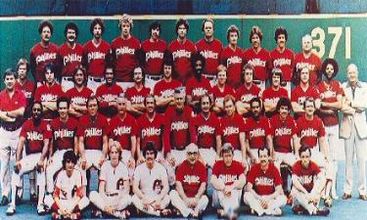 1980 World Champions Philadelphia Phillies |  2008 World Champions Philadelphia Phillies |
PHILLIES STADIUMS
 Baker Bowl 1887-1938 |  Connie Mack Stadium 1938-1970 |
 Veterans Stadium 1971-2003 | 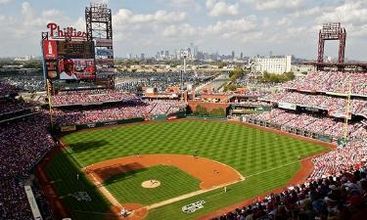 Citizens Bank Park 2004-Present |
Phamous Phillies
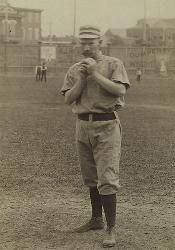 Charlie Ferguson 1884-1887 | 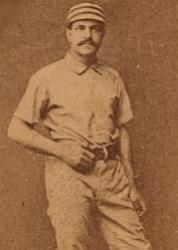 Sid Farrar 1883-1889 | 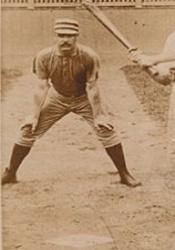 Jim Fogarty 1883-1889 |  Joe Mulvey 1883-1889, 1892 | 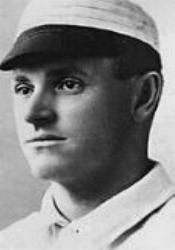 Billy Hamilton 1890-1895 | 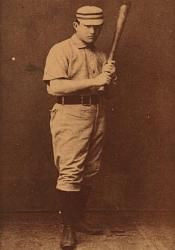 Jack Clements 1884-1897 |
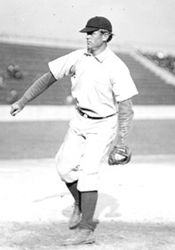 Jack Taylor 1891-1897 | 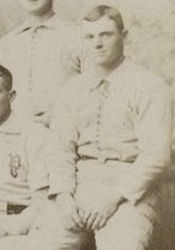 Kid Carsey 1892-1897 | 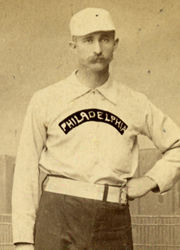 Sam Thompson 1889-1898 |  Nap Lajoie 1896-1900 | 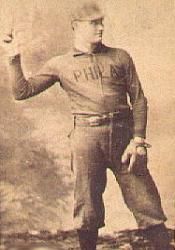 Ed Delahanty 1888-1889, 1891-1901 |  Al Orth 1895-1901 |
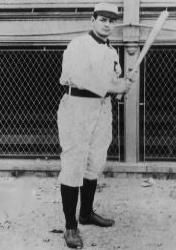 Elmer Flick 1898-1902 | 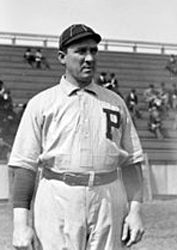 Bill Hallman 1888-89, 92-97, 1901-03 | 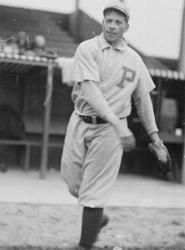 Bill Duggleby 1898, 1901-1907 | 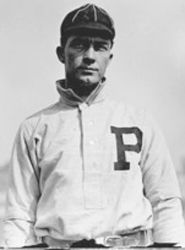 Tully Sparks 1897, 1903-1910 |  Roy Thomas 1899-1908, 1910-1911 |  Kitty Bransfield 1905-1911 |
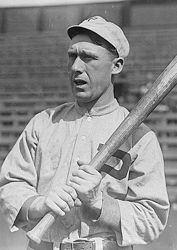 John Titus 1903-1912 |  Mickey Doolan 1905-1913 | 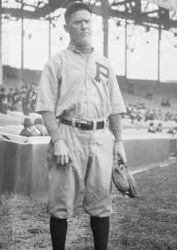 Red Dooin 1902-1914 |  Sherry Magee 1904-1914 |  Grover Cleveland Alexander 1911-1917, 1930 | 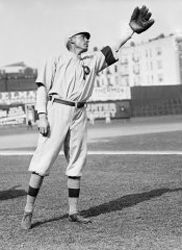 Dode Paskert 1911-1917 |
 Erskine Mayer 1912-1918 | 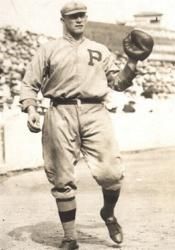 Fred Luderus 1910-1920 | 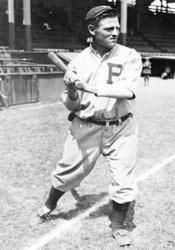 Gavvy Cravath 1912-1920 | 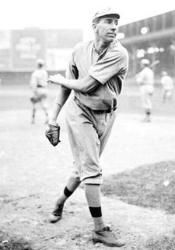 Eppa Rixey 1912-1920 |  Jimmy Ring 1921-1925, 1928 |  Cy Williams 1918-1930 |
 Spud Davis 1928-1933, 1938-1939 | 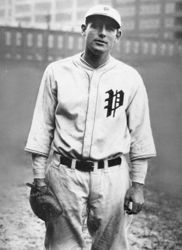 Don Hurst 1928-1934 | 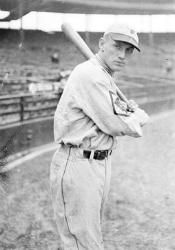 Chuck Klein 1928-33, 1936-39, 1940-44 1932 NL MVP |  Dolph Camilli 1934-1937 | 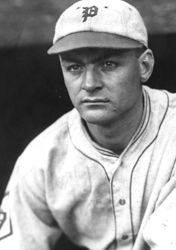 Jimmie Wilson 1923-1928, 1934-1938 |  Pinky Whitney 1928-1933, 1936-1939 |
 Hugh Mulcahy 1935-1940, 1945-1946 |  Ben Chapman MGR 1945-1948 | 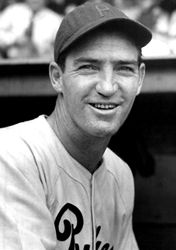 Schoolboy Rowe 1942-1943, 1946-1949 | 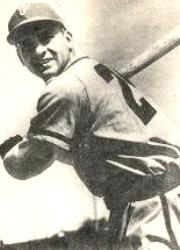 Andy Semminick 1943-1951, 1955-1957 |  Dick Sisler 1948-1951 | 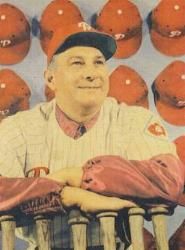 Eddie Sawyer MGR 1948-52, 1958-60 |
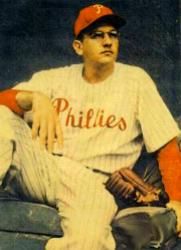 Jim Konstanty 1948-1954 1950 NL MVP | 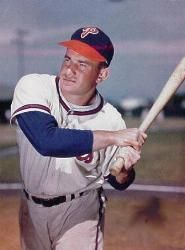 Del Ennis 1946-1956 |  Stan Lopata 1948-1958 | 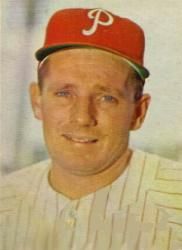 Jack Sanford 1956-1958 1957 Rookie of the Year |  Granny Hamner 1944-1959 | 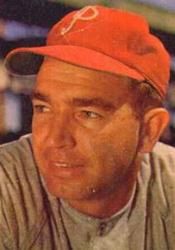 Willie Jones 1947-1959 |
 Richie Ashburn 1948-1959 | 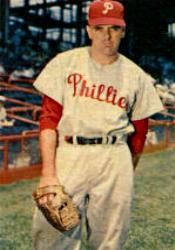 Curt Simmons 1947-1950, 1952-1960 | 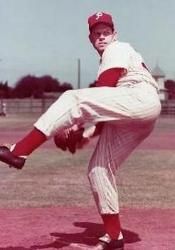 Robin Roberts 1948-1961 |  Gene Mauch MGR 1960-1968 |  Clay Dalrymple 1960-1968 |  Tony Gonzalez 1960-1968 |
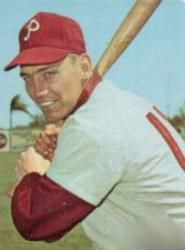 Bobby Wine 1960-1968 |  Johnny Callison 1960-1969 |  Richie Allen 1963-1969 1964 Rookie of the Year | 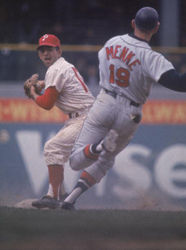 Cookie Rojas 1963-1969 | 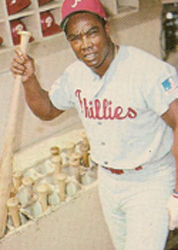 Tony Taylor 1960-1971 | 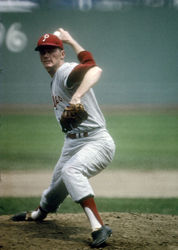 Jim Bunning 1964-1967, 1970-1971 6/21/64 Perfect Game |
 Rick Wise 1964, 1966-1971 | 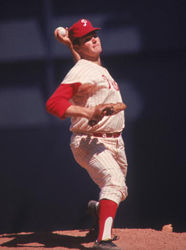 Chris Short 1959-1972 | 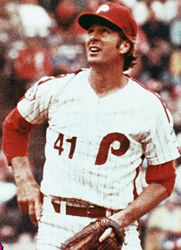 Jim Lonborg 1973-1979 | 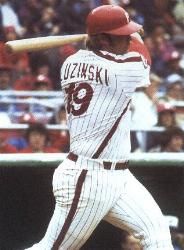 Greg Luzinski 1970-1980 | 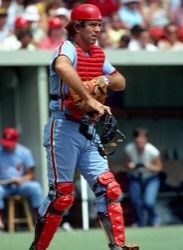 Tim McCarver 1970-1972, 1976-1980 |  Larry Bowa 1970-1981 |
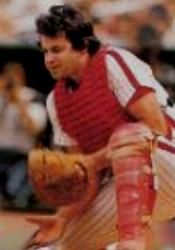 Bob Boone 1972-1981 |  Dallas Green MGR 1979-1981 |  Del Unser 1973-1974, 1979-1982 | 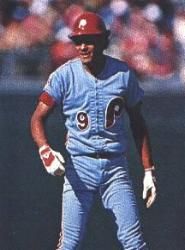 Manny Trillo 1979-1982 1980 NLCS MVP |  Mike Schmidt 1980, 1981, & 1986 NL MVP 1980 World Series MVP | 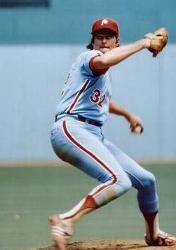 Steve Carlton 1972, 1977, 1980, 1982 Cy Young |
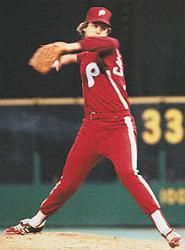 Larry Christenson 1973-1983 |  Dick Ruthven 1973-1975, 1978-1983 |  Ron Reed 1976-1983 |  Pete Rose 1979-1983 |  Gary Matthews 1981-1983 1983 NLCS MVP | 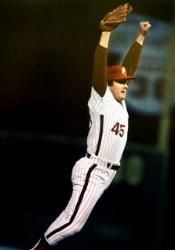 Tug McGraw 1974-1984 |
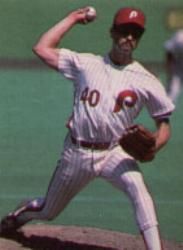 John Denny 1982-1985 1983 NL Cy Young | 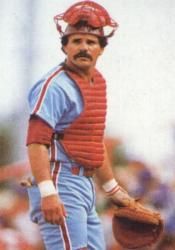 Bo Diaz 1982-1985 | 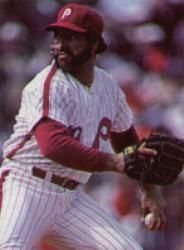 Al Holland 1983-1985 | 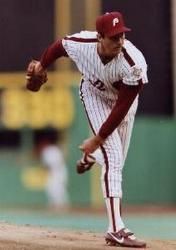 Steve Carlton 1972-1986 329 Wins 4,136 K's | 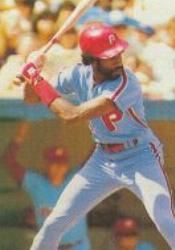 Garry Maddox 1976-1986 |  Glenn Wilson 1984-1987 |
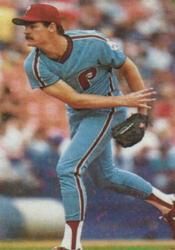 Kevin Gross 1983-1988 | 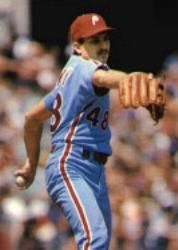 Shane Rawley 1984-1988 | 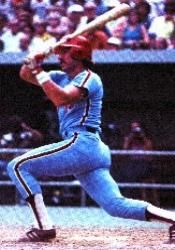 Mike Schmidt 1972-1989 548 Career HR |  Juan Samuel 1983-1989 |  Steve Bedrosian 1986-1989 1987 NL Cy Young | 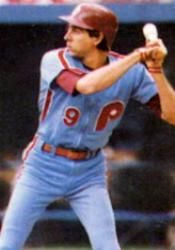 Von Hayes 1983-1991 |
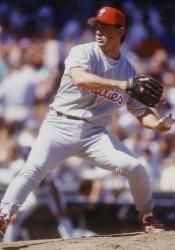 Terry Mulholland 1989-1993, 1996 | 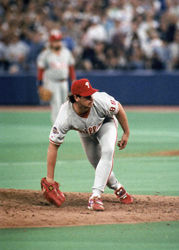 Mitch Williams 1991-1993 | 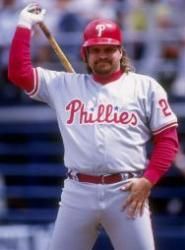 John Kruk 1989-1994 | 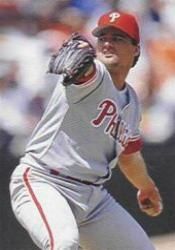 Danny Jackson 1993-1994 |  Lenny Dykstra 1989-1995 |  Tommy Greene 1990-1995 |
 Dave Hollins 1990-1995 | 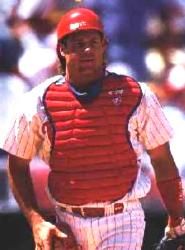 Darren Daulton 1983-1997 | 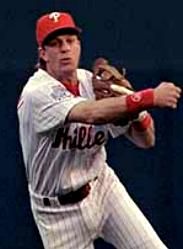 Mickey Morandini 1990-1997, 2000 | 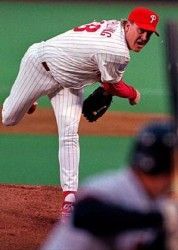 Curt Schilling 1992-2000 1993 NLCS MVP | 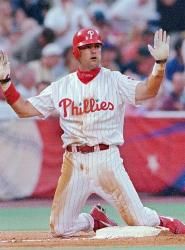 Rico Brogna 1997-2000 | 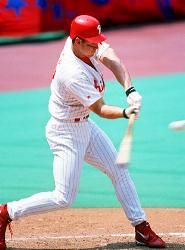 Scott Rolen 1996-2002 1997 Rookie of the Year |
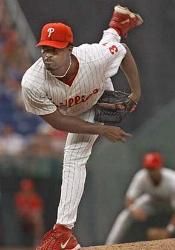 Robert Person 1999-2002 |  Jose Mesa 2001-2003 | 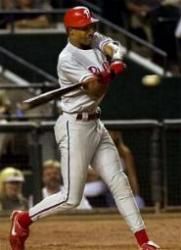 Doug Glanville 1998-2002, 2004 |  Kevin Millwood 2003-2004 | 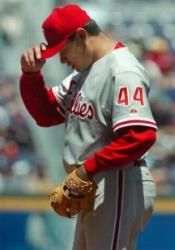 Vincente Padilla 2000-2005 | 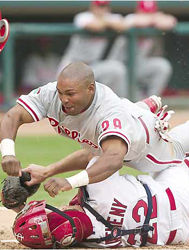 Marlon Byrd 2002-2005, 2014 |
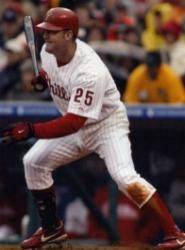 Jim Thome 2003-2005, 2012 | 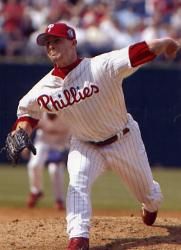 Billy Wagner 2004-2005 |  Mike Lieberthal 1994-2006 |  Bobby Abreu 1998-2006 |  Randy Wolf 1999-2006 | 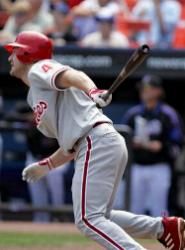 David Bell 2003-2006 |
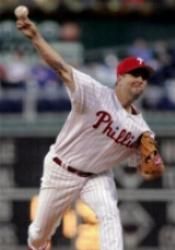 Corey Lidle 2004-2006 | 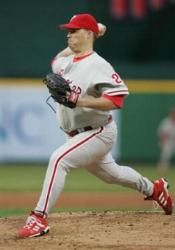 Jon Lieber 2005-2007 | 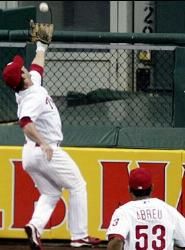 Aaron Rowand 2006-2007 | 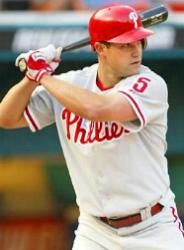 Pat Burrell 2000-2008 | 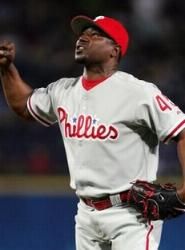 Tom Gordon 2006-2008 | 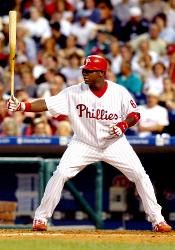 Ryan Howard 2005 Rookie of the Year 2006 NL MVP |
 Jimmy Rollins 2007 NL MVP | 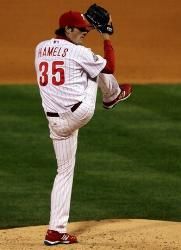 Cole Hamels 2008 NLCS & World Series MVP | 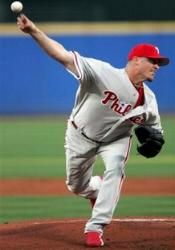 Brett Myers 2002-2009 |  Pedro Feliz 2008-2009 | 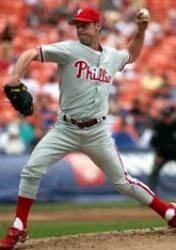 Jamie Moyer 2006-2010 | 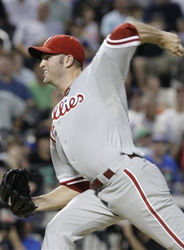 J.A. Happ 2007-2010 |
 Jayson Werth 2007-2010 | 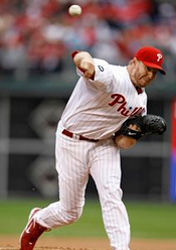 Roy Halladay 2010 Perfect Game 2010 NLDS No Hitter | 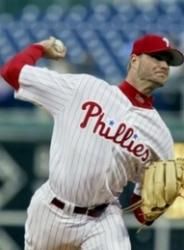 Ryan Madson 2003-2011 | 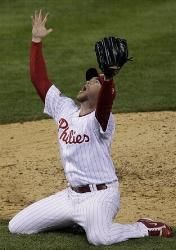 Brad Lidge 2008-2011 |  Raul Ibanez 2009-2011 |  Roy Oswalt 2010-2011 |
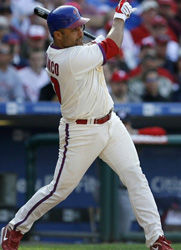 Placido Polanco 2002-2005, 2010-2012 |  Shane Victorino 2005-2012 | 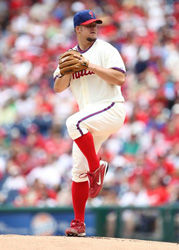 Joe Blanton 2007-2012 |  Vance Worley 2010-2012 | 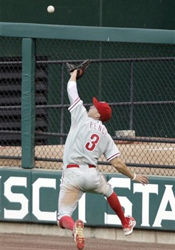 Hunter Pence 2011-2012 |  Charlie Manuel MGR 2005-2013 |
 Roy Halladay 2010-2013 2010 Perfect Game | 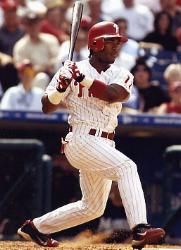 Jimmy Rollins 2000-2014 |  Kyle Kendrick 2007-2014 |  Antonio Bastardo 2009-2014 | 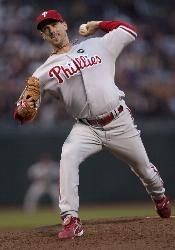 Cliff Lee 2009, 2011-2014 | 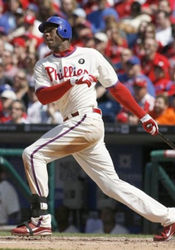 John Mayberry Jr. 2009-2014 |
 Chase Utley 2003-2015 | 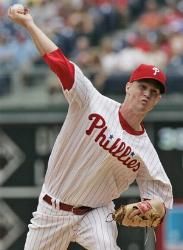 Cole Hamels 2006-2015 | 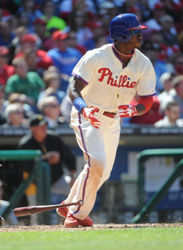 Dominic Brown 2010-2015 |  Jonathan Papelbon 2012-2015 | 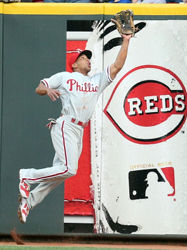 Ben Revere 2013-2015 | 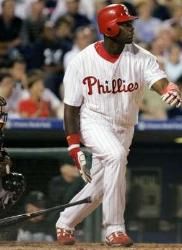 Ryan Howard 2004-2016 2009 NLCS MVP |
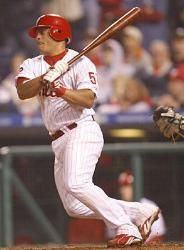 Carlos Ruiz 2006-2016 |  Darin Ruf 2012-2016 | 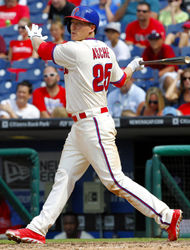 Cody Asche 2013-2016 | 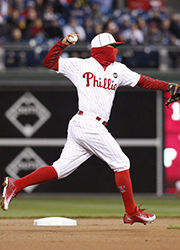 Freddy Galvis 2012-2017 | 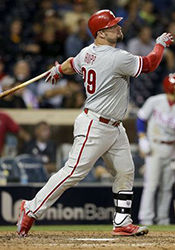 Cameron Rupp 2013-2017 |  Jeanmar Gomez 2015-2017 |
 Jeremy Hellickson 2016-2017 |  Tommy Joseph 2016-2017 | 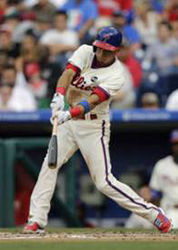 Cesar Hernandez 2013-2019 | 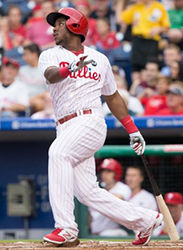 Maikel Franco 2014-2019 | 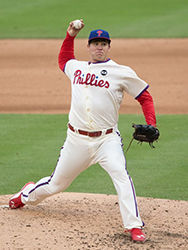 Jerad Eickhoff 2015-2019 | 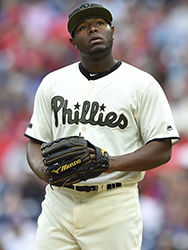 Hector Neris 2014-Present |
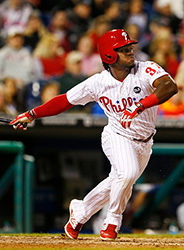 Odubel Hererra 2015-Present |  Aaron Nola 2015-Present | 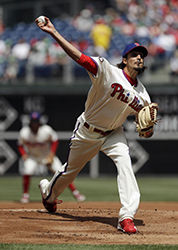 Zach Eflin 2016-Present | 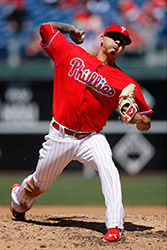 Vince Velasquez 2016-Present | 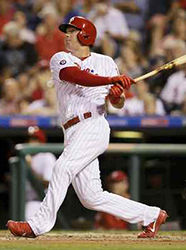 Rhys Hoskins 2017-Present | 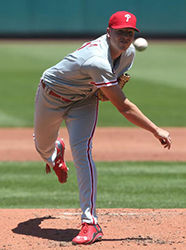 Nick Pivetta 2017-Present |
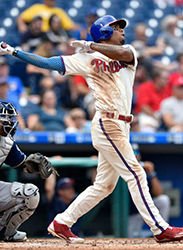 Nick Williams 2017-Present | 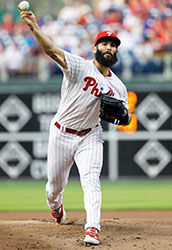 Jake Arrieta 2018-Present | 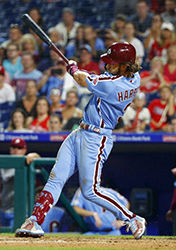 Bryce Harper 2019-Present | 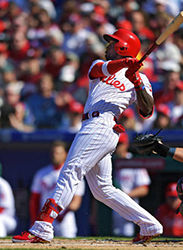 Andrew McCutchen 2019-Present | 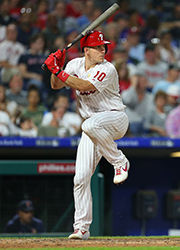 J.T. Realmuto 2019-Present | 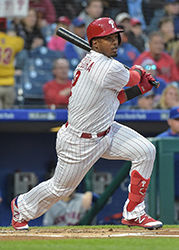 Jean Segura 2019-Present |
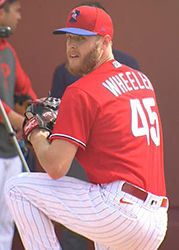 Zack Wheeler 2020-Pre |
